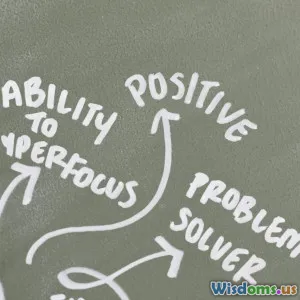
Five Real Life Stories of Perseverance Against the Odds
9 min read Inspiring real-life stories highlighting extraordinary perseverance, resilience, and triumph against adversity. (0 Reviews)
Five Real Life Stories of Perseverance Against the Odds
Every remarkable achievement has a backstory—often a narrative filled with challenge, resilience, and transformation. While talent and ambition are invaluable, it's the dogged perseverance through seemingly insurmountable obstacles that turns ordinary individuals into icons. In this article, we delve into five true stories from vastly different walks of life, drawing out actionable lessons from each struggle and triumph. These not only redefine the limits of human potential but offer a beacon of hope to anyone facing their own mountain to climb.
The Marathon of Spirit: Terry Fox’s Run Across Canada

In April 1980, a 21-year-old Canadian named Terry Fox dipped his artificial leg into the Atlantic Ocean, embarking on a cross-country run that would cover more than 5,300 kilometers. Diagnosed with osteogenic sarcoma at 18, Terry lost his right leg to cancer but gained a mission: to raise money and awareness for cancer research.
Endurance running is physically demanding even for able-bodied athletes. Terry faced additional pain—fighting the harsh Canadian elements and the blisters caused by his prosthesis. He ran the equivalent of a full marathon each day for 143 consecutive days. When cancer returned in his lungs and forced him to stop outside Thunder Bay, Terry had covered 3,339 miles. He raised $24 million (equivalent to over $71 million today).
Actionable Lessons:
- Even when the end goal seems unreachable, setting daily targets can turn a colossal mission into manageable steps.
- The power of purpose: Terry’s focus extended beyond himself—raising funds for others fueled his perseverance.
Serena Williams: Triumph Over Doubt and Adversity

Growing up in Compton, California, Serena Williams faced not just the rigorous challenges of tennis, but societal barriers, including systemic racism and sexism. Along with her sister Venus, Serena started playing on cracked public courts, often encountering discrimination from both competitors and the broader tennis community.
Her journey wasn’t just about winning Grand Slams; injuries (like a pulmonary embolism in 2011) and repeated comebacks punctuated her career. After giving birth in 2017 and developing life-threatening complications, Serena battled to return to the court, reaching four major finals as a mother.
Analysis: Serena rewrote what athletic perseverance means—not just in physical prowess but in emotional tenacity. She has amassed 23 Grand Slam singles titles, the most by any player in the Open era, inspiring women and minorities globally.
Tips from Serena’s Playbook:
- Never define yourself by others’ limited perceptions—use doubt as fuel.
- Champion your cause: Serena’s advocacy for gender equality broadens the impact of her victories.
The Artist Who Refused to Yield: Frida Kahlo

Frida Kahlo, the iconic Mexican painter, faced adversity from an early age. At six, she contracted polio, which left one leg thinner than the other. At 18, a bus accident shattered her pelvis, spine, and left her in chronic pain—her recovery required her to wear plaster body casts for months.
In these dark hours, Frida’s perseverance manifested in art. Confined to her bed, she painted self-portraits with motifs of pain, hope, and resilience. Despite undergoing more than 30 surgeries and unbearable suffering, she produced timeless works reflecting her inner world. Her unapologetic individuality blazed through crippling physical and emotional obstacles.
Comparison: Where many artists are celebrated posthumously, Frida’s acclaim began during her own lifetime, making her a symbol of overcoming both personal and societal confines. Her house in Coyoacán stands as a museum visited by millions, her story a testament to the intertwining of suffering and creativity.
Actionable Advice:
- Channel adversity into creative expression; self-discovery often happens in the shadow of hardship.
- Embrace authenticity—Frida’s fame endures because she never pretended her struggles didn’t exist.
Malala Yousafzai: A Voice Raised from the Valley

Malala Yousafzai’s path began in the Swat Valley of Pakistan. When the Taliban took control in 2008, they banned girls from attending school. At just 11, Malala spoke out on national television and began blogging anonymously for the BBC about her right to be educated.
In 2012, Taliban gunmen boarded Malala’s school bus, shooting her in the head. The attempt on her life galvanized international support—after months of recovery in the UK, Malala continued her activism stronger than ever. By 17, she became the youngest-ever Nobel Peace Prize laureate, helping champion education for girls globally.
How-To: Turning Trauma into Global Action
- Share your story: Malala’s diary entries gave a human face to a global crisis.
- Build alliances: Her foundation brings together policy-makers, donors, and grassroots organizers.
- Stay resilient in the face of threats—Malala’s unwavering courage sends a clear message: never be intimidated into silence.
The Scientist Who Redesigned Tomorrow: Stephen Hawking

Awarded a PhD at 23, Stephen Hawking was soon diagnosed with ALS, a rare neurodegenerative disease, and given two years to live. Only his mind remained unaffected. In a wheelchair, gradually losing his power of speech, Hawking’s determination never wavered.
He continued groundbreaking work in cosmology—his Hawking radiation theory changed our understanding of black holes. Using a single cheek muscle to communicate through a speech device, Hawking authored bestselling books and inspired generations with his wit, humor, and clarity.
Insights from Hawking’s Career:
- Limitations can inspire unique problem-solving: finding new ways to work or communicate leads to innovation.
- Perseverance isn’t about ignoring difficulties, but adapting intelligently to them.
Lessons for Our Own Journeys

What do these diverse journeys have in common? First, self-belief—each person viewed setbacks as detours, not dead-ends. Second, relentless adaptation—when existing routes failed, they blazed new trails. Third, a sense of purpose beyond themselves—a belief that their progress could illuminate pathways for others.
As we navigate our own hardships, large or small, each story offers actionable wisdom: set incremental goals, turn pain into fuel for growth, amplify your voice, adapt with creativity, and serve a cause greater than yourself. Obstacles may be formidable, but as these five figures show, the spirit of perseverance transforms every storm into a story of hope.
Rate the Post
User Reviews
Popular Posts



















